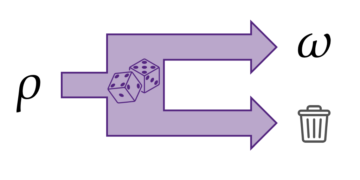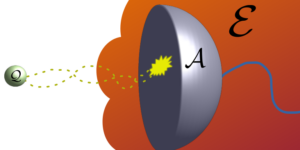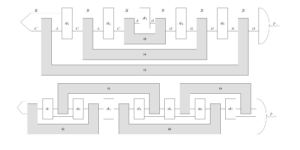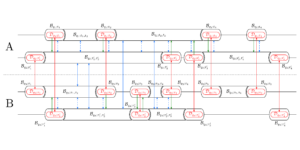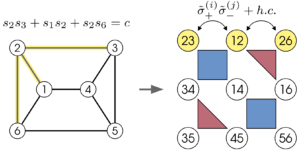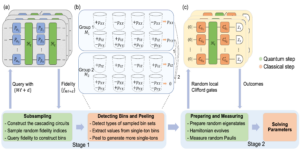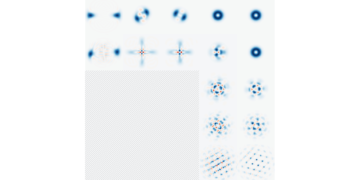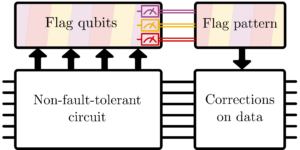
1QSTAR, INO-CNR and LENS, Largo Enrico Fermi 2, 50125 Firenze, Italy
2Ruhr University Bochum, 44801 Bochum, Germany
Find this paper interesting or want to discuss? Scite or leave a comment on SciRate.
Abstract
We construct a lower bound of the tensor rank for a new class of tensors, which we call $textit{persistent tensors}$. We present three specific families of persistent tensors, of which the lower bound is tight. We show that there is a chain of degenerations between these three families of minimal-rank persistent tensors that can be used to study the entanglement transformation between them. In addition, we show that these three families of persistent tensors are indeed different generalizations of multiqubit $rm{W}$ states within multiqudit systems and are geometrically in the orbit closure of multiqudit $rm{GHZ}$ states. Consequently, we show that one can obtain every one of the generalizations of $rm{W}$ state from a multiqudit $rm{GHZ}$ state via asymptotic Stochastic Local Operations and Classical Communication (SLOCC) with rate one. Finally, we extend the obtained lower bound of the tensor rank to direct sums with persistent summands and to even more general combinations of tensors, which we call $textit{block pyramidal tensors}$. As a result, we show that the tensor rank is multiplicative under the Kronecker and tensor products of minimal-rank persistent tensors with the $rm{GHZ}$ tensor.
► BibTeX data
► References
[1] R. Horodecki, P. Horodecki, M. Horodecki, and K. Horodecki, Quantum entanglement, Rev. Mod. Phys. 81, 865 (2009).
https://doi.org/10.1103/RevModPhys.81.865
[2] W. Dür, G. Vidal, and J. I. Cirac, Three qubits can be entangled in two inequivalent ways, Phys. Rev. A 62, 062314 (2000).
https://doi.org/10.1103/PhysRevA.62.062314
[3] A. Acín, D. Bruß, M. Lewenstein, and A. Sanpera, Classification of Mixed Three-Qubit States, Phys. Rev. Lett. 87, 040401 (2001).
https://doi.org/10.1103/PhysRevLett.87.040401
[4] A. G. Nurmiev, Orbits and invariants of cubic matrices of order three, Sb. Math. 191, 717, (2000).
https://doi.org/10.1070/SM2000v191n05ABEH000478
[5] A. G. Nurmiev, Closures of nilpotent orbits of cubic matrices of order three, Russ. Math. Surv. 55, 347, (2000).
https://doi.org/10.4213/rm279
[6] E. Briand, J.-G. Luque, J.-Y. Thibon, and F. Verstraete, The moduli space of three-qutrit states, J. Math. Phys. 45, 4855, (2004).
https://doi.org/10.1063/1.1809255
[7] F. Holweck and H. Jaffali, Three-qutrit entanglement and simple singularities, J. Phys. A: Math. Theor. 49, 465301, (2016).
https://doi.org/10.1088/1751-8113/49/46/465301
[8] M. Gharahi and S. Mancini, Algebraic-geometric characterization of tripartite entanglement, Phys. Rev. A 104, 042402 (2021).
https://doi.org/10.1103/PhysRevA.104.042402
[9] P. Bürgisser, M. Clausen, and M. A. Shokrollahi, Algebraic Complexity Theory (Springer-Verlag, Berlin, 1997). https://doi.org/10.1007/978-3-662-03338-8.
https://doi.org/10.1007/978-3-662-03338-8
[10] J. M. Landsberg, Tensors: Geometry and Applications (Graduate Studies in Mathematics, Vol. 128) (American Mathematical Society, Providence, RI, 2012). http://www.ams.org/publications/authors /books/postpub/gsm-128.
http://www.ams.org/publications/authors/books/postpub/gsm-128
[11] E. Chitambar, R. Duan, and Y. Shi, Tripartite Entanglement Transformations and Tensor Rank, Phys. Rev. Lett. 101, 140502 (2008).
https://doi.org/10.1103/PhysRevLett.101.140502
[12] N. Yu, E. Chitambar, C. Guo, and R. Duan, Tensor rank of the tripartite state $|rm{W}rangle^{otimes n}$, Phys. Rev. A 81, 014301 (2010).
https://doi.org/10.1103/PhysRevA.81.014301
[13] E. Chitambar, R. Duan, and Y. Shi, Multipartite-to-bipartite entanglement transformations and polynomial identity testing, Phys. Rev. A 81, 052310 (2010).
https://doi.org/10.1103/PhysRevA.81.052310
[14] L. Chen, E. Chitambar, R. Duan, Z. Ji, and A. Winter, Tensor Rank and Stochastic Entanglement Catalysis for Multipartite Pure States, Phys. Rev. Lett. 105, 200501 (2010).
https://doi.org/10.1103/PhysRevLett.105.200501
[15] N. Yu, C. Guo, and R. Duan, Obtaining a W State from a Greenberger-Horne-Zeilinger State via Stochastic Local Operations and Classical Communication with a Rate Approaching Unity, Phys. Rev. Lett. 112, 160401 (2014).
https://doi.org/10.1103/PhysRevLett.112.160401
[16] P. Vrana and M. Christandl, Asymptotic entanglement transformation between W and GHZ states, J. Math. Phys. 56, 022204 (2015).
https://doi.org/10.1063/1.4908106
[17] P. Vrana and M. Christandl, Entanglement Distillation from Greenberger–Horne–Zeilinger Shares, Commun. Math. Phys. 352, 621 (2017).
https://doi.org/10.1007/s00220-017-2861-6
[18] M. Gharahi, S. Mancini, and G. Ottaviani, Fine-structure classification of multiqubit entanglement by algebraic geometry, Phys. Rev. Research 2, 043003 (2020).
https://doi.org/10.1103/PhysRevResearch.2.043003
[19] P. Walther, K. J. Resch, and A. Zeilinger, Local Conversion of Greenberger-Horne-Zeilinger States to Approximate W States, Phys. Rev. Lett. 94, 240501 (2005).
https://doi.org/10.1103/PhysRevLett.94.240501
[20] J. Håstad, Tensor rank is NP-complete, J. Algorithms 11, 644 (1990).
https://doi.org/10.1016/0196-6774(90)90014-6
[21] L. Chen and S. Friedland, The tensor rank of tensor product of two three-qubit W states is eight, Linear Algebra App. 543, 1 (2018).
https://doi.org/10.1016/j.laa.2017.12.015
[22] N. Bourbaki, Algebra I (Elements of Mathematics) (Springer-Verlag, Berlin, 1989). https://doi.org/10.1007/978-3-540-35339-3.
https://doi.org/10.1007/978-3-540-35339-3
[23] P. Comon, G. Golub, L-H. Lim, and B. Mourrain, Symmetric Tensors and Symmetric Tensor Rank, SIAM J. Matrix Anal. Appl. 30, 1254 (2008).
https://doi.org/10.1137/060661569
[24] J. M. Landsberg and Z. Teitler, On the Ranks and Border Ranks of Symmetric Tensors, Found. Comput. Math. 10, 339 (2010).
https://doi.org/10.1007/s10208-009-9055-3
[25] Y. Shitov, A Counterexample to Comon's Conjecture, SIAM J. Appl. Algebra Geometry 2, 428 (2018).
https://doi.org/10.1137/17M1131970
[26] M. Christandl, A. K. Jensen, and J. Zuiddam, Tensor rank is not multiplicative under the tensor product, Linear Algebra App. 543, 125 (2018).
https://doi.org/10.1016/j.laa.2017.12.020
[27] M. Nielsen and I. Chuang, Quantum Computation and Quantum Information (Cambridge University Press, Cambridge, 2010). https://doi.org/10.1017/CBO9780511976667.
https://doi.org/10.1017/CBO9780511976667
[28] B. Alexeev, M. A. Forbes, and J. Tsimerman, Tensor rank: Some lower and upper bounds, In CCC '11: Proceedings of the 26th Annual IEEE Conference on Computational Complexity, p. 283-291 (IEEE Computer Society, NW Washington, DC, 2011). https://doi.org/10.1109/CCC.2011.28.
https://doi.org/10.1109/CCC.2011.28
[29] D. Li, X. Li, H. Huang, and X. Li, Simple criteria for the SLOCC classification, Phys. Lett. A 359, 428 (2006).
https://doi.org/10.1016/j.physleta.2006.07.004
[30] D. Coppersmith and S. Winograd, Matrix multiplication via arithmetic progressions, J. Symb. Comput. 9, 251 (1990).
https://doi.org/10.1016/S0747-7171(08)80013-2
[31] M. Christandl, F. Gesmundo, D. S. França, and A. H. Werner, Optimization at the boundary of the tensor network variety, Phys. Rev. B 103, 195139 (2021).
https://doi.org/10.1103/PhysRevB.103.195139
[32] J. Alman, V. V. Williams, Limits on All Known (and Some Unknown) Approaches to Matrix Multiplication, In 59th IEEE Annual Symposium on Foundations of Computer Science, p. 580–591 (IEEE Computer Society, NW Washington, DC, 2018). https://doi.org/10.1109/FOCS.2018.00061.
https://doi.org/10.1109/FOCS.2018.00061
[33] E. Schmidt, Zur Theorie der linearen und nichtlinearen Integralgleichungen, Math. Ann. 63, 433 (1907).
https://doi.org/10.1007/BF01449770
[34] A. Alder, V. Strassen, On the algorithmic complexity of associative algebra, Theor. Comput. Sci. 15, 201 (1981).
https://doi.org/10.1016/0304-3975(81)90070-0
[35] J. Buczyński, E. Postinghel, and F. Rupniewski, On Strassen's Rank Additivity for Small Three-way Tensors, SIAM J. Matrix Anal. Appl. 41, 106 (2020).
https://doi.org/10.1137/19M1243099
[36] J. M. Landsberg, M. Michałek, Abelian tensors, J. Math. Pures Appl. 108, 333 (2017).
https://doi.org/10.1016/j.matpur.2016.11.004
[37] Y. Wand, Z. Hu, B. C. Sanders, and S. Kais, Qudits and High-Dimensional Quantum Computing, Front. Phys. 8, 589504 (2020).
https://doi.org/10.3389/fphy.2020.589504
[38] N. J. Cerf, M. Bourennane, A. Karlsson, and N. Gisin, Security of Quantum Key Distribution Using d-Level Systems, Phys. Rev. Lett. 88, 127902 (2002).
https://doi.org/10.1103/PhysRevLett.88.127902
[39] J. Daboul, X. Wang, and B. C. Sanders, Quantum gates on hybrid qudits, J. Phys. A: Math. Gen. 36, 2525 (2003).
https://doi.org/10.1088/0305-4470/36/10/312
[40] L. Sheridan and V. Scarani, Security proof for quantum key distribution using qudit systems, Phys. Rev. A 82, 030301(R) (2011).
https://doi.org/10.1103/PhysRevA.82.030301
[41] C. Cafaro, F. Maiolini, and S. Mancini, Quantum stabilizer codes embedding qubits into qudits, Phys. Rev. A 86, 022308 (2012).
https://doi.org/10.1103/PhysRevA.86.022308
[42] D. Zhang, Y. Zhang, X. Li, D. Zhang, L. Cheng, C. Li, and Y. Zhang, Generation of high-dimensional energy-time-entangled photon pairs, Phys. Rev. A 95, 053849 (2017).
https://doi.org/10.1103/PhysRevA.96.053849
[43] L. E. Fischer, A. Chiesa, F. Tacchino, D. J. Egger, S. Carretta, and I. Tavernelli, Universal Qudit Gate Synthesis for Transmons, PRX Quantum 4, 030327 (2023).
https://doi.org/10.1103/PRXQuantum.4.030327
Cited by
Could not fetch Crossref cited-by data during last attempt 2024-01-31 14:39:14: Could not fetch cited-by data for 10.22331/q-2024-01-31-1238 from Crossref. This is normal if the DOI was registered recently. On SAO/NASA ADS no data on citing works was found (last attempt 2024-01-31 14:39:15).
This Paper is published in Quantum under the Creative Commons Attribution 4.0 International (CC BY 4.0) license. Copyright remains with the original copyright holders such as the authors or their institutions.
- SEO Powered Content & PR Distribution. Get Amplified Today.
- PlatoData.Network Vertical Generative Ai. Empower Yourself. Access Here.
- PlatoAiStream. Web3 Intelligence. Knowledge Amplified. Access Here.
- PlatoESG. Carbon, CleanTech, Energy, Environment, Solar, Waste Management. Access Here.
- PlatoHealth. Biotech and Clinical Trials Intelligence. Access Here.
- Source: https://quantum-journal.org/papers/q-2024-01-31-1238/
- :is
- :not
- ][p
- 07
- 08
- 1
- 10
- 11
- 12
- 125
- 13
- 14
- 15%
- 16
- 17
- 19
- 1981
- 20
- 2000
- 2001
- 2005
- 2006
- 2008
- 2009
- 2010
- 2011
- 2012
- 2014
- 2015
- 2016
- 2017
- 2018
- 2020
- 2021
- 2023
- 22
- 23
- 24
- 25
- 26
- 26th
- 27
- 28
- 29
- 30
- 31
- 32
- 33
- 35%
- 36
- 39
- 40
- 41
- 43
- 45
- 49
- 7
- 8
- 87
- 9
- 90
- a
- ABSTRACT
- access
- addition
- affiliations
- alder
- algorithmic
- algorithms
- All
- American
- and
- ann
- annual
- app
- applications
- approaches
- approaching
- approximate
- ARE
- AS
- At
- attempt
- author
- authors
- b
- BE
- berlin
- between
- border
- bound
- bounds
- Break
- by
- call
- cambridge
- CAN
- ccc
- chain
- chen
- Cheng
- citing
- class
- classification
- closure
- codes
- combinations
- comment
- Commons
- Communication
- complexity
- computation
- computational
- computer
- computer science
- computing
- Conference
- conjecture
- Consequently
- construct
- Conversion
- copyright
- could
- criteria
- data
- dc
- Den
- different
- direct
- discuss
- distribution
- during
- e
- eight
- elements
- embedding
- Ether (ETH)
- Even
- Every
- extend
- families
- Finally
- For
- Forbes
- found
- Foundations
- from
- front
- gate
- Gates
- Gen
- General
- generation
- geometry
- graduate
- harvard
- holders
- http
- HTTPS
- huang
- Hybrid
- i
- Identity
- IEEE
- if
- in
- indeed
- information
- institutions
- interesting
- International
- into
- Jan
- JavaScript
- journal
- Key
- known
- Last
- Leave
- Lens
- li
- License
- limits
- linear
- local
- lower
- math
- mathematical
- mathematics
- Matrix
- mixed
- Month
- more
- network
- New
- no
- normal
- obtain
- obtained
- obtaining
- of
- on
- ONE
- open
- Operations
- optimization
- or
- Orbit
- order
- original
- pages
- pairs
- Paper
- plato
- Plato Data Intelligence
- PlatoData
- present
- press
- Proceedings
- Product
- Products
- proof
- published
- publisher
- pure
- Quantum
- quantum computing
- quantum entanglement
- quantum information
- qubits
- R
- rank
- ranks
- Rate
- recently
- references
- registered
- remains
- research
- result
- s
- sanders
- SCI
- Science
- security
- Shares
- show
- siam
- Simple
- small
- Society
- some
- Space
- specific
- State
- States
- studies
- Study
- such
- sums
- Symposium
- synthesis
- Systems
- Testing
- that
- The
- their
- Them
- theory
- There.
- These
- this
- three
- Title
- to
- Transformation
- transformations
- two
- under
- unity
- Universal
- university
- unknown
- URL
- used
- using
- variety
- via
- volume
- W
- wand
- wang
- want
- was
- washington
- ways
- we
- which
- Williams
- Winter
- with
- within
- works
- X
- year
- zephyrnet
- zhang

